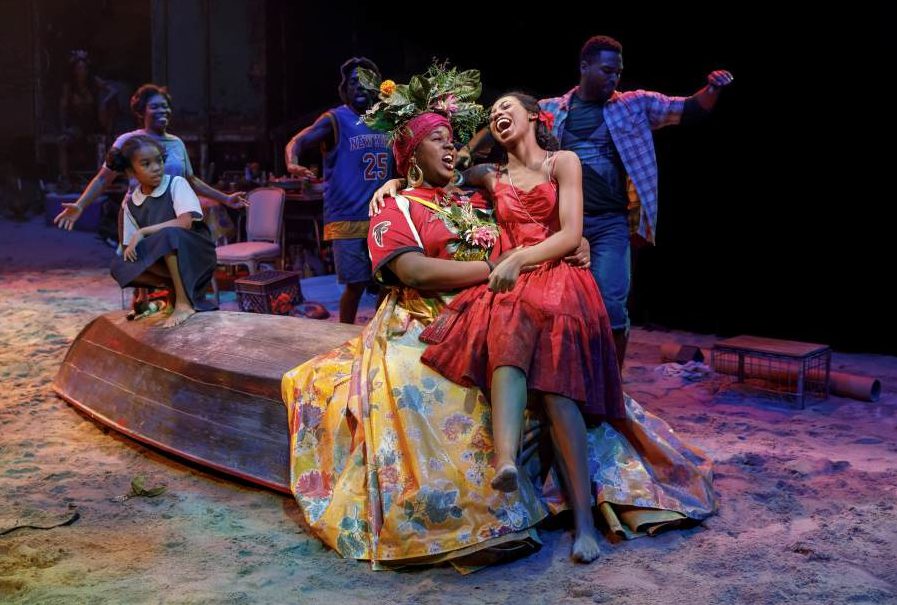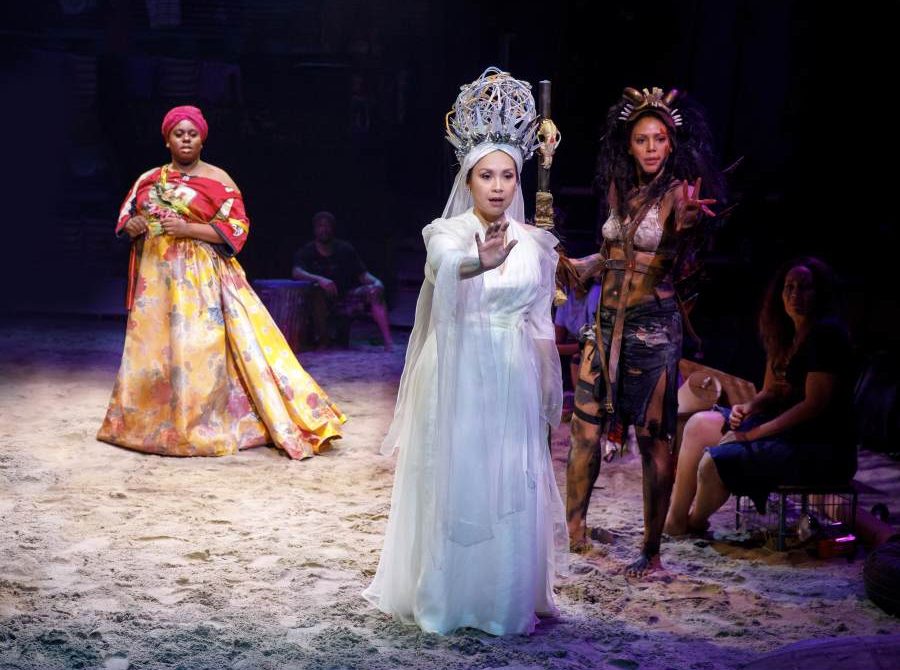Ny Times Review of Once on This Island

"Love has many powers. If the love is true, information technology can cross the earth and withstand the storm."
With just 1 step into the Circumvolve in the Foursquare Theatre, you lot're immediately immersed in the authenticity of this magical, mystical Caribbean island. As you make your mode to your seat, you'll hear the sound of rolling waves encompassing the room, as you accept notation of the clotheslines that border the back of the auditorium, boasting tie-dyed outerwear of the island inhabitants. Down beneath, the islanders bicker companionably and pal around with each other, establishing the communal attribute of the individual islanders, while displaying hints of the rivalry that will presently fuel the principal incentives of the plot. To kicking, the floor of the phase is completely enveloped in sand, a feat bested only past the actual running water, which gathers in a pool at stage left. And just when you retrieve it couldn't get any more surreal, a live caprine animal premises from ane side of the infinite to the other. And with that, you've arrived. You're living the life of these inhabitants along with them, and yous know — before a single scripted line is even spoken — that it'll exist an feel you'll never forget.
Part Romeo and Juliet, part Fiddling Mermaid, all turned on its head with a calypso-infused Haitian twist, Once on This Island,by Lynn Ahrens (book/lyrics) and Stephen Flaherty (music), tells the story of Antillean peasant girl Ti Moune, who dreams of reuniting with the white-skinned k-homme Daniel from the other side of the island, after saving him from a devastating car accident on the local streets. Guided by the gods of beloved, water, and Earth — while skillfully evading the Demon of Expiry — she'southward put to the ultimate examination of life and loyalty, forced to evidence one time and for all that the strength of love can withstand the ability of death.
With such classic hits as "Waiting for Life," "Forever Yours," and "Mama Volition Provide" (the latter number being particularly impactful in this iteration, cheers to a powerhouse operation by Glee fave Alex Newell), there's no question the love score is clearly a highlight of the experience, touching our hearts merely as much now every bit it did throughout the musical'south original 1990 Broadway run. Simply, as seasoned theatergoers can tell you, the cardinal to any successful revival is in its ability to present the material anew, uncovering new elements and opening new doors, to allow the audience to separate the production from its predecessor. Without fail, incomparable managing director Michael Arden undeniably succeeds in this attempt, injecting the production — only every bit he did in helming the smash-hit Deaf Westward production ofLeap Awakening in 2015 — with his unparalleled Midas touch.

Information technology's all in his embrace of using the nuts: sound is produced non from a sound system, only from the utilization of constitute objects, be they rainsticks, torn electrical tubes, broken beer bottles, tire parts, or other scraps and remnants strewn about the streets as a result of the disastrous storm that occurs early on in the story. Similarly, Daniel'southward vehicle is fashioned from actors grabbing four dissever car parts and joining him at center, navigating the storm with a atypical steering cycle. When one person steps upward to tell a office of the story, the others fill in with noises like the audio of a bird or the clap of a thundercloud. When the Gods call upon their corresponding elements (amid them burn down, steam, air current, and pelting, to proper name a few) their furnishings emanate throughout the theatre.
All these components are essential factors into what gives this revival its refreshingly original feel. But information technology'southward Arden'southward work in this aforementioned opening sequence that leaves the biggest mark, peculiarly given the story equally a whole, with almost the entire cast gathered in day apparel interacting with each other, just as average neighbors or townspeople do in their daily lives. Gods, healers, and storytellers they may soon become, but for these starting time opening moments, they're simply average people. Just every bit united states "ordinary folk" are settling in to see this story come alive, they're also portrayed as boilerplate people, taking a break from their work, coming together to hear this story. This option, coupled with Arden'south decision to gender-bend a handful of pivotal characters, helps to stress the idea that while we are all different people and come from different backgrounds, much similar the people of the Gem of the Antilles, we are all 1, united in our pain, grief, hope, faith, and most importantly, our unconditional life. The story they unfold for usa is a universal ane, and at its heart, it affects us all the same: even the ordinary can get extraordinary. In presenting information technology through the lens of the inhabitants portraying literal storytellers, it allows us to have the universality as truth, resulting in a powerful, poignant punch when it all somewhen unravels at prove's terminate.
In terms of the performers themselves, well, yous know you tin can't go any better than this trusty group. Backed by perennial standouts like Tony-nominee Philip Boykin, whose booming baritone volition instantly cure all your troubles, and Broadway's token princess Lea Salonga, who ignites all the feels with her commitment of "The Human Eye," the supporting cast is nothing short of delightful, as is lauded leading human Isaac Powell, who commands the room in a first-rate debut equally the aristocratic Daniel.
Just information technology becomes articulate fairly quickly that the success of a show like this i lies squarely on the shoulders of its youthful leading lady. With an impressive air of maturity and a set of dazzling dulcet tones to match, there's no question 18-year-old newcomer Hailey Kilgore is up to the task, carrying the intimate production on her nimble limbs with ease and aplomb. She may be one small daughter, merely she's clearly a force to be reckoned with, proving herself non simply worthy but capable of beingness in a league all her ain. She's the fresh face with the big eye, and the even bigger voice — equally compelling in the heart-wrenchingly heavy dramatic moments as she is the lighthearted ones, demurely heedless of a life free of prejudice and obstacle. No matter what the scene calls for, this surefire star-in-the-making brings her A-game and delivers in spades. Just put, she is an unequivocal star. And while Ti Moune'southward journey may end each night at final coma, information technology's clear Kilgore's journey is but beginning. She's going somewhere….going far. And oh, what a beautiful story she'll weave.
morissetdremetweithe1959.blogspot.com
Source: https://stagebuddy.com/theater/theater-review/review-once-on-this-island
0 Response to "Ny Times Review of Once on This Island"
Post a Comment